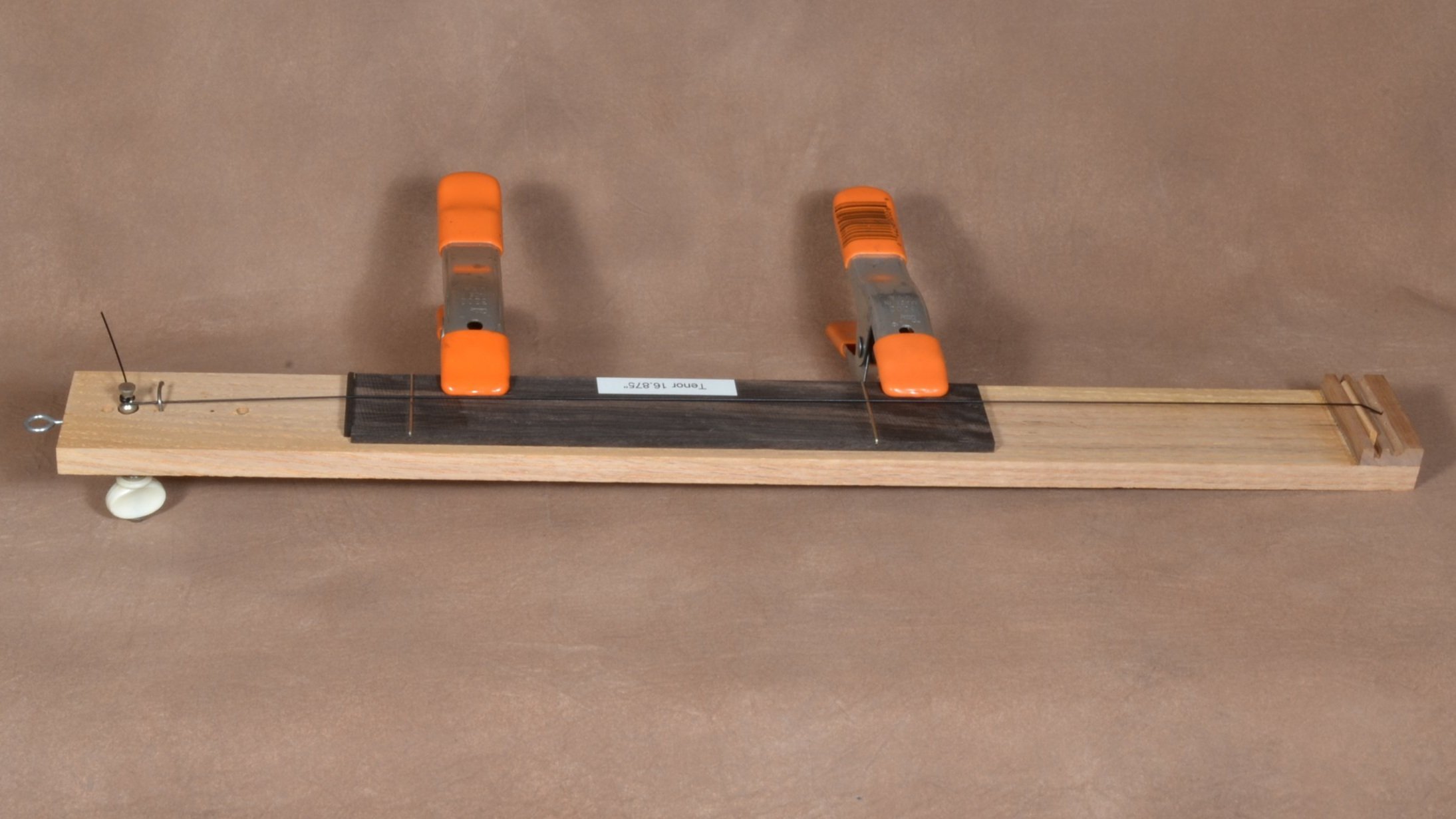GAL UKULELE SCALE INTONATION
UKULELE SCALE INTONATION
This is the method that I use to locate bridges on my instruments. It’s a fixture where I can determine a measurement, which I then use to make a measuring stick to be used as a locator when placing the bridge.
I build ukuleles and am presenting this method as I use it. You’ll have to use your imagination and cleverness to modify this system if you want to use it for other instruments.
With the ukulele’s re-entrant tuning (g-C-E-A) and traditional straight saddle I make my calculations and measurement from the E string which is the ‘mid’ string on a ukulele. With perfect (?) intonation on the E string the other strings will be pretty darned close.
THE JIG
My fixture is simply a board with a bridge glued onto one end and a single tuner at the other end. I string it with an E string, different string makers use different gauges, I use an average ‘E’ gauge of .030” to .032”
My Fixture
Test Fretboard
I’ve made a ‘test’ fretboard for each scale length that I wanted to determine a measurement for.
The ‘test’ fretboards have the nut end accurately cut off and have frets installed at #1 and #12.
THE SET UP
I start by clipping the fretboard to the string fixture at about the right position.
A good starting position is the measurement from nut to the 12th + about 1/8” from the saddle. Then I set the action to be the same as it will be on a finished instrument. For a tenor scale length ukulele, I use the specifications of .016” under the 1st fret and .100” under the 12th fret.
Clipping the fretboard to the string fixture
Tapered Wedge Saddle
I use a tapered wedge saddle to set the height at the bridge.
String tension
String tension will hold the nut in place. I file the string guide slot to achieve my correct string height.
DETERMINING THE MEASUREMENT
Using an electronic tuner, I tune the open string to pitch (E). Sounding the harmonic at the 12th fret position gives me the true octave pitch. Then I gently fret the 12th fret and pluck the string, which gives me the fret placement pitch. If the fretted pitch is higher than the harmonic, the fretboard needs to be moved away from the bridge. If the fretted pitch is lower than the harmonic, move the fretboard closer to the bridge.
I will mess about with the set-up adjustment until I find that sweet spot where the open string, the plucked harmonic and the fretted octave all match pitch (of course the open string is down an octave). I then will lock it down and make a jig.
Using an Electronic Tuner
MAKING A JIG
The jig makes a hardcopy of this measurement, which I use to determine my bridge location when making an instrument.
Acrylic Measurement Jig
I have changed the way I have made the measurement jigs over the years.
The first ones I made were acrylic (hard to glue straight). Then I made one with a brass rod drilled to hold two steel pins (a bit overkill), and finally I settled on making them out of a quality hardwood dowel drilled for the two pins.
On a completed instrument I still have a little latitude in adjustability with where the crown of the saddle is placed but I find that I almost never have to mess with having the crown anywhere but on center as the accuracy of the bridge placement will be quite good. I have gotten numerous favorable comments over the years of how ‘in tune’ my ukuleles play.
Article by Peter Hurney, originally published in Guild of American Luthiers Magazine, “Ukulele Scale Intonation.”








